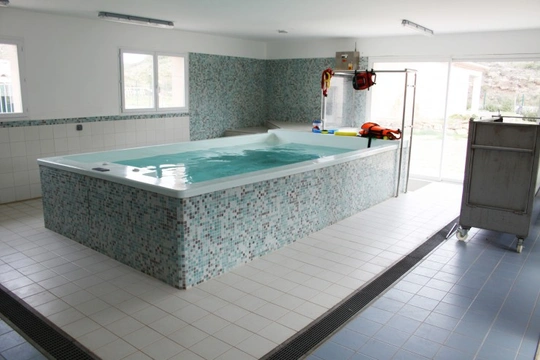
Canine hydrotherapy at home
Hydrotherapy is a type of swimming therapy that is often used for the rehabilitation of people, and more recently, dogs as well. There are a huge number of advantages of hydrotherapy for dogs of all types, and regular visits to the pool can help to improve muscle mass, improve your dog’s range of movement and help to keep them flexible, by taking part in a supportive, low impact form of exercise without drugs.
There are a range of canine hydrotherapy pools dotted all over the UK, and you can either make an appointment with them to take your dog along for a taster session to see if regular treatment might help them, or get a referral from your vet as part of their care and therapy protocol. In many cases, dog insurance policies will cover the cost of canine hydrotherapy when recommended by the vet, meaning that today, more and more dogs are getting their paws wet in the pool!
A proper canine hydrotherapy pool is designed and installed with dogs in mind, and in this way, differs considerably from both human hydrotherapy pools and swimming pools. If you have the space and funds available, you might have considered installing a canine hydrotherapy pool at home for your own dog, and while this is certainly worthy of potential consideration, you cannot just dig a pool, fill it with water, and put your dog in it!
In this article, we will look at some of the pros and cons of having a canine hydrotherapy pool installed at home. Read on to learn more.
What sort of dogs can hydrotherapy help?
Hydrotherapy is recommended for a wide range of dogs, such as those that need more exercise without placing additional pressure on their joints, dogs with conditions such as arthritis, and those recovering from surgery.
However, hydrotherapy can also be used to keep healthy dogs fit and supple, as part of their normal exercise protocols.
Some of the main uses for canine hydrotherapy pools include:
- Therapy after surgery.
- To relieve the pain of arthritis and retain movement.
- To ease muscle pain and soreness.
- To keep dogs with degenerative conditions mobile for longer.
- Teaching dogs to swim in a safe, stress free environment.
- As part of a weight loss regime.
- To provide stress-free exercise.
- As a normal form of full body, low impact exercise.
What makes a hydrotherapy pool?
As mentioned, canine hydrotherapy pools differ from regular hydrotherapy pools and swimming pools in a whole host of ways, and are designed and built specifically with dogs in mind.
They are designed to allow dogs to walk into the water or be hoisted in without having to jump in or out, and will contain equipment such as harnesses to support swimming dogs. The water itself will be maintained at a warm, comfortable temperature, and the water will be treated with a different combination of chemicals and agents than would be used in a swimming pool, in order to avoid drying the dog’s skin.
The pros of installing your own pool at home
There are a range of advantages to installing your own hydrotherapy pool at home, if you have the space and money to fund it! Firstly, you can have the pool designed to meet the needs of your own dog, tailoring the build to suit them and what will work best for them. You can also ensure that only your own dog or dogs that you know use the pool, reducing the chance of your dog picking up an infection or illness through shared facilities.
You can also use the pool for your own dog as and when you wish to, without having to make appointments and transport your dog elsewhere.
The cons of installing your own pool at home
First of all, it is important to note that designing, installing and running your own pool doesn’t come cheaply, and the financial cost of doing so will be an obstacle for many dog owners. Added to this, any person using the pool should have training in delivering hydrotherapy to dogs and be experienced in doing so, in order to avoid worsening any problems or causing accidents. This means committing to training in the necessary skills to use your own pool at home.
You will also need to consider how useful the pool will be to you after your own dog has eventually passed away; will you continue to use it, or will it prove to be an expensive investment that does not ultimately provide good value?
You should also think about the time needed to maintain a pool of this type, taking into account maintenance, the cost of water treatment, and testing the water parameters.
For most dog owners, taking their dog to a treatment centre that has a hydrotherapy pool works out to be the most sensible and cost effective solution in the long term, but if you have the funds and commitment for installing your own pool at home and can justify the expense in terms of usage and the advantages that it provides, it may be worth considering.



